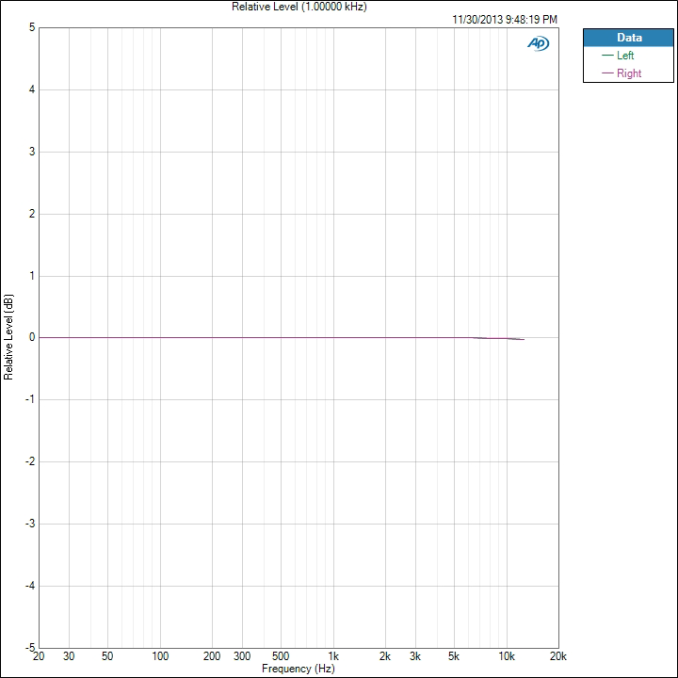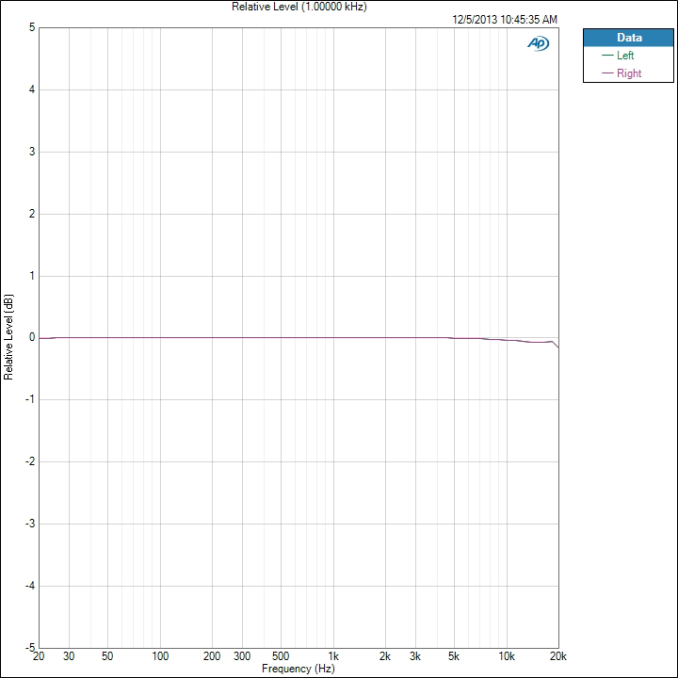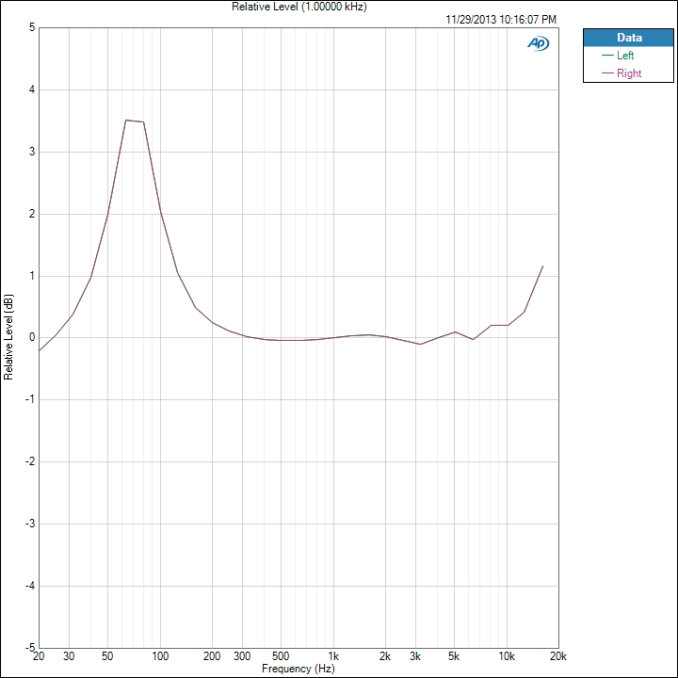Smartphone Audio Quality Testing
by Chris Heinonen on December 8, 2013 5:15 PM EST- Posted in
- Smartphones
- Audio
- Mobile
- Tablets
- Testing
Maximum Level
The maximum output level is derived from the 1kHz test tone used to determine THD+N. The higher the output from the headphone jack, the louder it can drive a pair of headphones. More importantly, having more power available means when you have dynamic music passages that call for power you are less likely to clip the waveform.
There is no chart to show here, just a number that the Audio Precision gives us. In our test data, the most powerful phone was the iPhone 5, at 32.46 mW of power. Next is the Nexus 5 at 22.24 mW, though we can’t drive it that high. Then the Note 3 at 11.81 mW and finally the Galaxy S4 at 3.895 mW. Doubling the power, from 4 mW to 8 mW, produces a 3 dB increase in volume level. 3 dB is the smallest change in volume levels we can easily hear. So even though the iPhone 5 produces 32 mW vs. 4 mW, that is only a 9 dB difference in volume. 10 dB is doubling the volume, so it isn’t even twice as loud. If you have demanding headphones, you will want as much power as you can get.
Frequency Response
To measure the frequency response we measure a set of 61 tones from 20 Hz to 20 kHz. All of these are then equalized to 1 kHz so we can see the maximum deviation from that level. An ideal phone will be perfectly flat here and allow you to adjust this with an EQ setting, or though your taste in headphones. On this test our best performing phone is the Galaxy S4, as seen here.
The total variation from 1 kHz is only 0.014 dB which is very good. The worst performing phone is the iPhone 5, but its variation is only 0.089 dB.
The iPhone 5 also picked up the 20 kHz tone while the Samsung and many others missed it. If we dropped this tone then it might be just as flat. The iPhone 5 test was run slightly differently, as it can't run the Android test program, which might account for this. For a phone with a different response, here is the HTC One with Beats enabled. Other HTC One testing is still in progress as I write this article.
Here we see that Beats is adding a +3.5 dB boost from 60 Hz to 90 Hz, but the deviation from 0 dB goes from 30Hz to 300 Hz. Past 6.5 kHz we also see a rise in the treble. People often mistake boosted treble for extra detail, which is likely the reasoning behind this. As we see it is far different than the other two examples we looked at.













188 Comments
View All Comments
ph00ny - Thursday, December 12, 2013 - link
i9100 had yamaha DAC and was dismissed by many as poor choice moving away from wolfson DAC which sounded especially great with voodoo sound. As for S3, US variants with Snapdragon did not come with Wolfson DACThe Von Matrices - Sunday, December 8, 2013 - link
I own an S3 and I hate that it's output has a bass boost profile similar to the HTC One with its "Beats" profile. It's probably great for earbuds but for any other listening device the bass is overdriven. If it just produced a flat output I would be completely happy with it.Impulses - Monday, December 9, 2013 - link
Can't it be turned off somewhere? HTC's Beats glorified EQ can be turned off and ignored entirely, well, except for the persistent notification that lets you know that it is indeed turned off (seriously).Samus - Monday, December 9, 2013 - link
A lot of custom roms try to circumvent Samsung audio layer with a combination of audio filters. Its pretty depressing...S3 owner here.speculatrix - Tuesday, December 10, 2013 - link
Xda devs is full of discussions about things like boeffla Kernel tweaks and hacks which expose more of the hardware controls of Wolfson DACs and thus allow customization of sound EQ.It does seem to be the case that you really do have to research a specific phone and all it's variants to be sure of getting the audio chain you want.
barry spock - Monday, December 9, 2013 - link
Excellent stuff. I hope you can do a showdown of the most popular phone models out there at the moment, including the iphone 5s.PrinceGaz - Monday, December 9, 2013 - link
I'd like to see iPod touch models added to the mix also, as whilst not actually a smartphone, it is in many ways very similar and music listening on it through the headphone jack is a major selling point of it. The thing is, as you don't need to hear it "ring" in a loud room, it has a much weaker internal speaker than any smartphone, so is the audio-amp driving the earphone socket as good as that of the iPhone, or have they saved money on it to hit the lower price point?Bansaku - Tuesday, December 10, 2013 - link
I too would like to see this as well. Especially between the 4th and 5th Gen. I swear the audio quality of my 4th Gen is superior to my 5th Gen. I also wonder the difference between the various models of iPhones.JoannWDean - Saturday, December 14, 2013 - link
my buddy's aunt earned 14958 dollar past week. she been working on the laptop and got a 510900 dollar home. All she did was get blessed and put into action the information leaked on this site... http://cpl.pw/OKeIJotipoo - Sunday, December 8, 2013 - link
This is perfect, I havn't read it all but I have an ancient Nexus S and it has horrendous headphone output. I've heard the next two Nexii weren't great in that either. Lots of hiss from all the radios, and even if there was no hiss there's just an odd EQ curve or something, it makes the bass muddy. I think the program Voodoo sound helped it but not completely. So audio output will be an important consideration in my next phone.